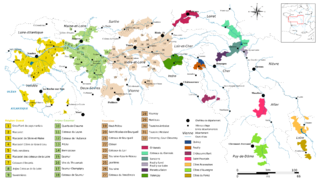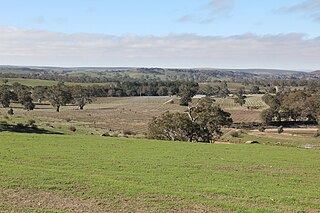
Chilean wine has a long history for a New World wine region, as it was the 16th century when the Spanish conquistadors brought Vitis vinifera vines with them as they colonized the region. In the mid-19th century, French wine varieties such as Cabernet Sauvignon, Merlot, Carmenère and Franc were introduced. In the early 1980s, a renaissance began with the introduction of stainless steel fermentation tanks and the use of oak barrels for aging. Wine exports grew very quickly as quality wine production increased. The number of wineries has grown from 12 in 1995 to over 70 in 2005.

The Coonawarra wine region is a wine region centred on the town of Coonawarra in the Limestone Coast zone of South Australia. It is known for the Cabernet Sauvignon wines produced on its "terra rossa" soil. Coonawarra is an Aboriginal word meaning "Honeysuckle". It is about 380 km southeast of Adelaide, close to the border with Victoria.

Wrattonbully is a wine region in South Australia's South East, between the Padthaway and Coonawarra regions, between the Riddoch Highway and the Victorian border.

New Zealand wine is produced in several winegrowing regions of New Zealand. The country's elongated island geography in the South Pacific Ocean results in maritime climates with considerable regional variation from north to south. Like many other New World wines, it is usually produced and labelled as single varietal wines, or if blended the varietal components are listed on the label. New Zealand is best known for its Marlborough Sauvignon Blanc, and more recently its dense, concentrated Pinot Noir from Marlborough, Martinborough and Central Otago.

Romania is one of the world's largest wine producers and fifth largest among European wine-producing countries, after Italy, France, Spain, and Germany. In 2018 it produced around 5.2 million hectolitres of wine. In recent years, Romania has attracted many European business people and wine buyers, due to the affordable prices of both vineyards and wines compared to other wine-producing nations such as France, Germany, and Italy.

The South Australian wine industry is responsible for more than half the production of all Australian wine. South Australia has a vast diversity in geography and climate which allows the state to be able to produce a range of grape varieties–from the cool climate Riesling variety in the Clare Valley wine region to the big, full bodied Shiraz wines of the Barossa Valley.

The Loire Valley wine region includes the French wine regions situated along the Loire River from the Muscadet region near the city of Nantes on the Atlantic coast to the region of Sancerre and Pouilly-Fumé just southeast of the city of Orléans in north central France. In between are the regions of Anjou, Saumur, Bourgueil, Chinon, and Vouvray. The Loire Valley itself follows the river through the Loire province to the river's origins in the Cévennes but the majority of the wine production takes place in the regions noted above. The area includes 87 appellations under the Appellation d'origine contrôlée (AOC), Vin Délimité de Qualité Superieure (VDQS) and Vin de pays systems. While the majority of production is white wine from the Chenin blanc, Sauvignon blanc and Melon de Bourgogne grapes, there are red wines made from Cabernet franc. In addition to still wines, rosé, sparkling and dessert wines are also produced. With Crémant production throughout the Loire, it is the second largest sparkling wine producer in France after Champagne. Among these different wine styles, Loire wines tend to exhibit characteristic fruitiness with fresh, crisp flavors-especially in their youth. The Loire Valley has a long history of winemaking dating back to the 1st century. In the High Middle Ages, the wines of the Loire Valley were the most esteemed wines in England and France, even more prized than those from Bordeaux.

Victorian wine is wine made in the Australian state of Victoria. With over 600 wineries, Victoria has more wine producers than any other Australian wine-producing state but ranks third in overall wine production due to the lack of a mass bulk wine-producing area like South Australia's Riverland and New South Wales's Riverina. Viticulture has existed in Victoria since the 19th century and experienced a high point in the 1890s when the region produced more than half of all wine produced in Australia. The phylloxera epidemic that soon followed took a hard toll on the Victoria wine industry which did not fully recover till the 1950s.

Eden Valley wine region is a wine region located in South Australia immediately north of the capital city of Adelaide which covers an area in the Mount Lofty Ranges extending from Truro in the north to just south of Springton in the south. The region received appellation as an Australian Geographical Indication in 1997 and as of 2014, it is represented by at least 36 wineries.

Kangaroo Island wine region is a wine region which covers the full extent of Kangaroo Island in South Australia. The wine region is one of five wine regions comprising the Fleurieu zone. The term ‘Kangaroo Island’ was registered as an Australian Geographical Indication under the Wine Australia Corporation Act 1980 on 8 December 2000. As of 2014, the region is reported as containing at least 30 growers and 12 wineries. As of 2014, the most common plantings within the region within a total planted area of 140 ha was reported as being Shiraz (35.7%) followed by Cabernet Sauvignon (30.7%) and Chardonnay (7.1%).
Mount Gambier wine region is a wine region located in the south east of South Australia around the regional city of Mount Gambier. The first planting of vines occurred in 1982. The region received appellation as an Australian Geographical Indication in 2010 and as of 2014, is represented by 20 vineyards and eight wineries.

Limestone Coast zone is a wine zone located in the south east of South Australia. It extends south of a line of latitude approximately in line with Cape Willoughby at the east end of Kangaroo Island and it is bounded by the continental coastline and the border with Victoria. It consists of the following wine regions all of which have received appellation as an Australian Geographical Indication (AGI): Coonawarra, Mount Benson, Mount Gambier, Robe, Padthaway, Wrattonbully and a small number of vineyards located outside the above regions. The zone received AGI in 1996.
Southern Fleurieu wine region is a wine region in South Australia that is located on the Fleurieu Peninsula and the portion of the Mount Lofty Ranges extending north east from the peninsula to near Willunga in the west and to near Ashbourne in the east. The region received appellation as an Australian Geographical Indication (AGI) in 2001 and as of 2014, has a total planted area of 510 ha and is represented by 50 growers and at least 19 wineries.

The Peninsulas zone is a wine zone located in South Australia that covers the entire Yorke Peninsula, an adjoining portion of the Mid North of South Australia, the portion of Eyre Peninsula south of a line of latitude approximately in line with Crystal Brook and the islands located off the adjoining coastline. The zone is bounded by the Far North zone to its north by the Mount Lofty Ranges zone to its east. The term ‘The Peninsulas’ was registered as an Australian Geographical Indication under the Wine Australia Corporation Act 1980 on 27 December 1996.
Adelaide Plains wine region is a wine region located in South Australia immediately north of the capital city of Adelaide. The region received appellation as an Australian Geographical Indication in 2002 and as of 2014, it is represented by 11 wineries. It is part of the Mount Lofty Ranges zone.

Adelaide Hills is an Australian geographical indication for wine made from grapes grown in a specific area of the Adelaide Hills east of Adelaide in South Australia.
Robe is a wine region located in the south east of South Australia immediately adjoining the town of Robe. The region received appellation as an Australian Geographical Indication (AGI) in 2006. It is part of the Limestone Coast wine zone.
Padthaway wine region is a wine zone region located in the south east of South Australia immediately adjoining a section of the Riddoch Highway including the town of Padthaway. The region received appellation as an Australian Geographical Indication (AGI) in 1999.

Langhorne Creek wine region is a wine region in South Australia that is located on the plains southeast of the town of Strathalbyn along the lower reaches of the Bremer River and Angas River to Lake Alexandrina. The region received appellation as an Australian Geographical Indication (AGI) in 1998 and as of 2014, has a total planted area of 5,883 ha and is represented by at least 24 wineries.
Currency Creek wine region is a wine region in South Australia that is located on the west side of Lake Alexandrina between Milang, the Murray Mouth, Port Elliot and just south of Ashbourne. The region received appellation as an Australian Geographical Indication (AGI) in 2001 and as of 2014, has a total planted area of 960 ha and is represented by at least four wineries.












